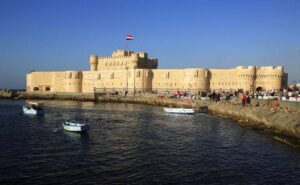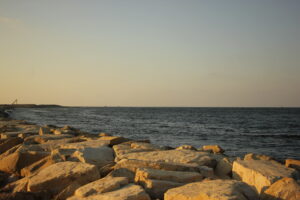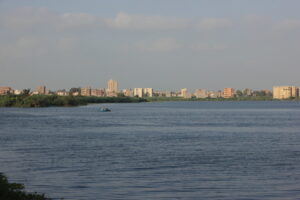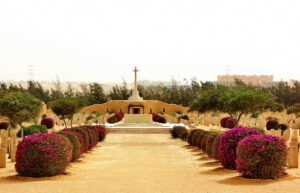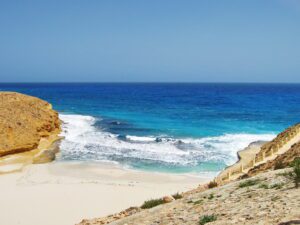
Alexandria and Mediterranean coast
Alexandria is one of the most well-known names when it comes to tourism in Egypt, and rightly so. Out of the twenty-four cities across the world, Egypt’s Alexandria is the oldest and most famous of them all. Its history, ancient architecture, beaches, and atmosphere fascinate all who come to visit. With its Ancient library and lighthouse, Alexandria was the centre for trade, learning and culture in the Ancient world.
Founded in 332 BC by Alexander the Great, after whom the city is named, Alexandria was the capital of Egypt for almost a thousand years, extending about 32km (20 miles) along the Mediterranean Sea coast.
People of Egypt envy Alexandrian’s for living in such a beautiful city. It has a different character than the rest of Egypt, due to being the main harbour connecting Egypt with the world for thousands of years. In summer, people from all over Egypt rush to the city to enjoy its beaches, atmosphere and cooler climate. In modern history, it’s the most famous and most beautiful cosmopolitan city around the world, where art, architecture and wealth intertwine together.
Alexandria and Mediterranean coast
- AlexandriaAlexandria is one of the most well-known names when it comes to tourism in Egypt, and rightly so. Out of the twenty-four cities across the world, Egypt’s Alexandria is the oldest and most famous of them all. Its history, ancient architecture, beaches, and atmosphere fascinate all who come to visit. With its Ancient library and lighthouse, Alexandria was the centre for trade, learning and culture in the Ancient world. Founded in 332 BC by Alexander the Great, after whom the city is named, Alexandria was the capital of Egypt for almost a thousand years, extending about 32km (20 miles) along the Mediterranean Sea coast. People of Egypt envy Alexandrian’s for living in such a beautiful city. It has a different character than the rest of Egypt, due to being the main harbour connecting Egypt with the world for thousands of years. In summer, people from all over Egypt rush to the city to enjoy its beaches, atmosphere and cooler climate. In modern history, it’s the most famous and most beautiful cosmopolitan city around the world, where art, architecture and wealth intertwine together. What to see: Hewn into 35m (115ft) of solid rock is the Catacomb of Kom El-Shoqafa. This is the largest known Roman burial site in Egypt. Its design and decoration is a fusion of Greco-Roman and Ancient Egyptian religious elements, which is typically found in Alexandrian art. The fusion has created a unique catacomb and consists of labyrinth tombs, dating back to the 1st and 2nd Centuries AD. If there is one reason alone to go to Alexandria, it is the Bibliotheca Alexandrina. Its huge structure to around 17 years to build and cost over $355 million. It was inaugurated in 2002. The building boasts 11 stories, 8 million books, specialized libraries and several museums, as well as a planetarium and a conference centre. The highest memorial pillar in the world is Pompey’s Pillar. Built from Red Aswan Granite, it stands at 30m (98ft) and was constructed in honour of Emperor Diocletian in the 4th century AD. Scattered around the pillar is the remains of the Serapeum of Alexandria dating back to the 3rd century BC. The Roman Theatre was built in the 2nd century AD. The theatre stood with 13 semi-circular tiers of seats, able to hold up to 800 spectators, built with white marble imported from Europe. Its columns are made of red Aswan granite, and the wings on either side are decorated with geometric mosaic pavings. To the east lies a large villa that dates back to the reign of Emperor Hadrian (117-138 AD). It is named the ‘Villa of the Birds’, because its magnificent mosaic flooring depicted various species. At the north of the site is a Roman bathhouse, which is thought to be the oldest and largest public bath found in Alexandria so far. The excellent Alexandria National Museum sets high standards for showing off Alexandria’s past. With a small, thoughtfully arranged collection, it does a sterling job of relating the city’s history from the Ancient Period to the Modern Period. It was inaugurated in 2003 and includes over 1800 artefacts. The Qaitbey Fort, built-in 1477 by Sultan Qaitbey on the site of the Ancient lighthouse Pharos ( one of the ancient Seven Wonders of the World). Parts of the lighthouse remain and can be seen in the construction of the fort. more than 2000 artefacts still lie under the water in the harbour around the fort, for divers looking for underwater sunken treasures. CLOSED FOR RENOVATION AT END OF 2021, DaTE of reopening not known as yet Montazah palace The Montazah Palace Complex lies in the east-most part of the city. The drive to El Montazah gives you a great chance to behold the most beautiful part of the city’s coast and beaches. The Palace’s 115-acre complex, which belongs to the Mohamed Ali family, contains two palaces and a private harbour giving a mesmerizing view over The Mediterranean. The complex is scattered with picturesque gardens, palm trees and gazelles. The construction of the site began in 1892, and it is a wonderful spot to enjoy the beauty of Alexandria and the favourite locations for Alexandrian families. The Royal Jewellery Museum is an architectural masterpiece. Its halls contain many rare paintings and decorations, and a massive collection of jewels belonging to the Mohamed Ali family is also exhibited. The Mostafa Kamel and Shatby cemeteries include a few tombs dating from the 3rd to 2nd century BC, second in importance to only the catacombs, and rarely seen by tourists. The Mosque of Abu al-Abbas al-Mursi was built in 1775, on an older museum that dates back to the 13th century. This beautiful mosque, with its high minaret and 4 domes, is Alexandria’s largest and one of the most important Islamic monuments and pilgrim spots for many Sufi Muslims. Around this, there are some other historical mosques, such as the El Bousiri mosque. Saint Mark Cathedral is the most important Coptic Orthodox church in Alexandria. It’s the historical seat of the Pope of Alexandria as the Head of the Coptic Orthodox Church. The cathedral is said to stand on the site of the church founded by St. Mark the Evangelist, the founder of Christianity in Egypt in AD 60, giving the cathedral its name. The Cavafy Museum is dedicated to Constantine Cavafy, a great poet born in Alexandria in 1863. His parents were Greek and his body is buried in the Greek cemetery. The museum is his house, with his original furniture, pictures and rare editions of his books. There is also a room dedicated to another Greek writer, Stratis Tsirkas. The Old Market is a maze of small streets which house hundreds of little shops, stalls and boutiques. No cars can fit through, and the market is called Zinqat as-Sittat market (which literally translates to ‘the women’s squeeze’) as a result. Near Fort, Qaitbey is the Alexandria Aquarium, which exhibits many species of fish and other aquatic life from The Mediterranean and the Red Sea around Egypt, as well as some freshwater species from The Nile and the Amazon. Alexandria is a common summer resort for Egyptians with some excellent beaches and in summer these are incredibly popular. it is significantly more modest than on Red Sea beaches. Montazah Beach and Mahmoura are both very well known.

- RosettaRosetta (Rasheed). Rosetta, referred to in Egypt as Rasheed, is famous for the discovery of the Rosetta stone, which made deciphering hieroglyphics possible. Due to the strategic position of Rosetta, where the Nile meets the Mediterranean Sea, it became an important trade centre throughout Medieval and modern history. Many mosques, caravanserai and houses are witnesses to the prosperity of the Medieval city. It is a tranquil place with extensive gardens, orchards, and date palm plantations. Highlights include the Rosetta National Museum, formerly the governor’s residence, and taking a walking tour of the old market. Visit QaitBay Fort, built in 1479 to guard the meeting point between the Nile and the Mediterranean Sea, and Abu Mandour Shrine, dedicated to a local Muslim saint and a pilgrimage site for many of the locals. The city covers an area of roughly 92 square kilometers or 9200 hectares. In 1517, under Ottoman rule, Rosetta became a prosperous trading harbour. The city attracted the attention of both Britain and France, which were major colonial powers that controlled trade between Europe and the East. As a result, Rosetta turned into one of the most flourishing Mediterranean harbours. Its warehouses were replete with grains, coffee, silk, and many other trading commodities, and its streets were bustling with rich merchants, consuls of European countries, as well as Armenian, Turkish, Syrian and Jewish traders. In addition to all this, many elegant hotels, mosques, churches, houses, and inns were built. The town itself is an open museum, with 22 monumental residences dating back to the Ottoman Era, in addition to 12 mosques, mills, castles and public baths. It is a tranquil and highly green town with vast gardens, orchards, and date-palm plantations. What to see: Built-in the traditional Delta style using small, flat bricks painted alternately red and black, the Ottoman houses reflect a skilled style of architecture, construction and carpentry. Designed to match the Islamic architectural style, the houses comprise vast reception rooms, decorative, in-laid sea shell woodworks, domes and densely ornamented doors. The interior of the house was rich with exquisite decorations, including inscriptions in Kufic calligraphy. Some of the houses also have Mushrabiyyas (oriels), which were made of geometrically shaped fine wood. There are around 22 houses, most of which are being restored there are, however, a few are open for visitors. These include the Asfour, Abu Shaheen, Ramadan, and Amasyali Houses. There are 12 historical mosques, but there are 3 particularly interesting mosques: Al- Mahali Mosque (1721 AD) has a ceiling supported by 99 columns from ancient Alexandrian monuments, Zaghlul Mosque is the oldest Mosque in Rosetta (1577 AD), and Abbasi Mosque (1809AD) is the most beautiful mosque in Rosetta, its façades decorated with molded bricks as the façades of the old houses of the city. The Al- Mahali, and Zaghlul mosques are important mosques to see, both recently refurbished. Fort of Qaitbey was built in 1479 to guard the mouth of The Nile. It was at this spot that the famous Rosetta stone was found. One of the most extraordinary buildings, the Azouz Bath (Hammam) is a 400-year-old bathhouse, which was still in operation even in 1980, using water pumped in from The Nile. It features a fine marble interior with elaborately carved wooden ceilings. Abu Mandour is an old shrine dedicated to a local Muslim Sheikh, built on a spur in the Nile Branch South or Centre of Rosetta. It has been a pilgrimage site for many of the locals and a good place to meet local people and begin to understand the local culture. The Arab Killi House and Rosetta National Museum, formerly the governor’s residence, is now the home of the city museum. It shows the history and the culture of the city through its exhibitions. Built-in the 13th century AD, The Abu Shaheen Mill is a double mill turned by horses, for grinding grains. Rosetta Mouth is where the Rosetta Nile branch meets the Mediterranean Sea.

- FuwwahFuwwah is a UNESCO world heritage site, which lies on the Western Nile branch (Rosetta). Its name, in Arabic, is the name of a plant that is known for its rose pigment used in dyeing clothes and fezzes. Fuwwah’s population is roughly 65,000. It houses a huge number of Islamic monuments, mosques, Sufism buildings, and commercial buildings. But few people are aware that it has many other monuments that are well worth visiting. Fuwwah and Rosetta exchanged their importance because of their locations between the Mediterranean and the Western Branch of the Nile, both are considered the most flourishing Mediterranean harbors. The history of Fuwwah dates back to the Pharaonic era, during which it was the capital of the 7th province of Lower Egypt. In the Greek Era, it was called Mitlis, which means the city of the foreigners, referring to the Greeks who migrated to the West of the Nile Delta during the end of the Pharaonic Era. Apart from the historical and architectural importance of Fuwwah, it’s famous for ‘kleem’ the famous Egyptian handmade carpet made of cheap wool. Many workshops still produce floor tiles using the old techniques. Those attractions are hard to miss, as they are almost around every street corner. Fuwwah is also famous for its local market and fishing community. In Fuwwah, the fishermen’s houses are clustered around the Nile Branch Bank, and the best way to view it is from a motorboat or a small oar boat on a short trip on The Nile. What to see: The Mosques of Fuwwah are characterized by the red bricks they are built with, which are coloured by the Nile Silt. Sometimes, the bricks are alternately red and black, and they also used white between courses, with stepped crenellations at the top of walls, like the hanging Mamluk Mosque of Al-Qinani, which has the best pulpit all over Fuwwah, and the Ottoman Mosque of Abu-Almakarm. During the 15th Century, Prince Hassan Nasr-Allah was born and brought up for a time in Fuwwah, where he studied mathematics and The Qur’an. He was extraordinarily smart, and the governor of the town sent him to study in Cairo and eventually go to Al-Azhar University. He joined the Madrasa of Sultan Hussain, one of the greatest at the time. However, he did not join Al-Azhar University, but instead served in various governmental positions, including the minister of the army. During the reign of Sultan Al-Ashraf Bersbay, he was accused of embezzlement, and his money was confiscated, so he made a vow that if he got acquitted, he would build a mosque in his birthplace. God fulfilled his wish, and he built the Madrasa and Mosque of Prince Hassan Nasr-Allah. Al-Tikiya Al-Khalawatiya once served as the residence place for the Sufis; the word ‘khalawatiya’ is the name of one of the Sufi groups. It was the only existing example in The Delta and it was ruined and rebuilt. It has bedrooms, study rooms, and a mosque. Rabaa Al-Khatiba is an inn for caravanserais and merchants inn who came to sell their products in Fuwwah. It has three floors: the ground floor contains the storage rooms and the stables, the first floor contains bedrooms, bathrooms, and kitchens, and the third floor was the place where the merchants would have been entertained by groups of musicians. In 1824, Muhammad Ali ordered the governor of Fuwwah to build a factory for fezzes; The gates of the factory still stand today. He started to construct the factory and an expert from Tunisia supervised the construction. In 1837, the daily production reached 120 fezzes. The production covered the needs of Egypt and fezzes were exported to various countries. During excavations, some molds that were used to shape the fezzes were unearthed and are now preserved in the Tanta Museum, but the factory is long gone now. if you are interested in Egypt’s modern history, a tour of these workshops is a great learning experience

- El Alamein“Before El Alamein, we never had a victory. After El Alamein we never had a defeat,” said Winston Churchill, during his Hinge of Fate speech. El-Alamein, a small coastal outpost, is famous for the decisive victory doled out here by the Allies in WWII. The shadows of the conflict, in which over 80,000 soldiers were injured or died, are still present around here and in the surrounding battlefields. The translation of El-Alamein is “Two Worlds,” or “Two Flags,” a suitable name for the turning point of the North African campaign, which ultimately determined the fate of Egypt, and Britain’s Empire. Tourists with an interest in the history of WWII should not miss a chance to visit such a key location. The location itself is beautiful, with Churchill himself having said that this place enjoys the best climate in the world. The multiple shades of blue of the sea paired with the fine sands truly live up to this description. The Sidi Abd El Rahman beach resort overlooks the best bay on Egypt’s Mediterranean coast. Today, El-Alamein is still occupied by Bedouin communities. Around a three-hour drive to the West of Cairo, there is an expanse which was named The Devil’s Garden. Here, the local Bedouins are still sometimes injured and killed by the approximately, 16 million land mines that are scattered around the expanse, rendering the battlefield itself too dangerous to explore. The thousands of graves in the Commonwealth, German and Italian war cemeteries in the vicinity of the town are a bleak reminder of the losses on all sides, a [place of peace and tranquility for all of the those who visit. What to see: El-Alamein War Museum is a great introduction to the North African campaigns of WWII, including the Battle of El Alamein. It’s an intriguing collection of memorabilia, uniforms, and photos that leave us a personal reminder of the soldiers that fought here. Outside, a range of tanks, artillery, and hardware from the battle is displayed. “lest we forget”. The haunting rows of 7,367 tombstones of The Commonwealth War Cemetery commemorate the deaths of soldiers from the UK, Australia, New Zealand, France, Greece, South Africa, East, and West Africa, Malaysia, and India who fought for the Allied cause. The 11,945 other souls whose bodies were never found are memorial cloisters, praising them for their bravery and courage. At the end of an oleander-lined avenue is a white marble tower, The Italian War Memorial. It has a small museum and chapel dedicated to the 42,800 Italian soldiers, sailors, and airmen who died during the campaign. A squat octagonal structure, modeled on the Castel del Monte in Apulia, is the German War Memorial. Its courtyard covers a mass grave of 4,280 soldiers, whose names are recorded on plaques beside stone sarcophagi, representing the soldiers’ home provinces. The soldiers of Greece, Australia, and South Africa also have their own humble memorials.

- Marsa MatruhMarsa Matruh, or the comatose state, gives you an experience of brilliant-white sand and turquoise-lined bays in Egypt. Marsa Matruh was founded by Alexander the Great on his way to Siwa. According to tradition, it was a place where Mark Anthony and Cleopatra sought solace after their defeat at Actium. It lies on a bay on the Mediterranean and is distinguished by its 7 km (4.5 miles) long Cleopatra beach, which – as all visitors have testified – is one of the most beautiful beaches in the world. In the summer months of June to September, half of the Lower Nile Valley descends on this sleepy Mediterranean town for their annual holiday. During this time the streets buzz with people late into the night, throngs of street stalls sell hot food and souvenirs, and impromptu street musicians bang out rhythmic tunes. The two key streets in Marsa Matrouh are: The Corniche- which winds its way around the waterfront, Alexandria Street, which runs perpendicular to the Corniche. What to see: Agiba Beach, or ‘Miracle’ beach, is about 24km (15 miles) West of Marsa Matrouh. It is distinguished by its numerous natural caves and enchanting scenery. The water here is dazzlingly clear turquoise, though it isn’t ideal for toddlers, as the waves roll in strongly. Cleopatra’s Beach is possibly the most beautiful piece of coastline in the area and lies about 14km (9 miles) west of town, around the bay’s thin tentacle of land. The sea here is an exquisite hue, and the rock formations are worth a look. You can wade to Cleopatra’s Bath, a natural pool where legend has imagined the great queen and Mark Anthony enjoying a dip, but there’s actually no swimming due to the waves and rocks just offshore. Lido Beach, the main beach in town, has golden sands and clear water. Calm, shallow water is great for small kids to play in and there are also palm-frond shades for you to relax under. The remains of the Egyptian Fleet Anchorage, built during the reign of the Ptolemy Pharaohs, still stand west of the port. Rommel’s hideout is a cave hewn in the rock, where Rommel drew up plans of his military operations in WWII. It has now been turned into a military museum. Matrouh is a wonderful relaxing resort that can be added to the end of any tour through Luxor, Cairo, Aswan, and Alexandria.


